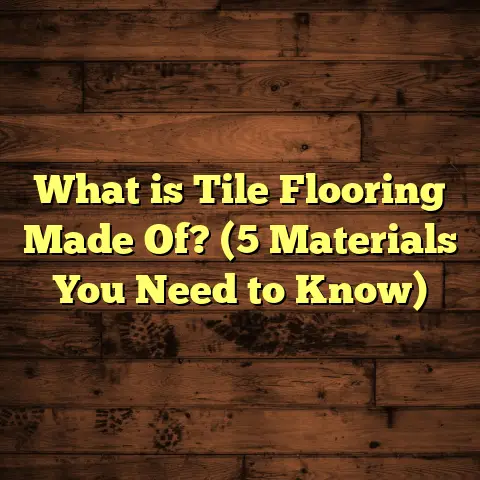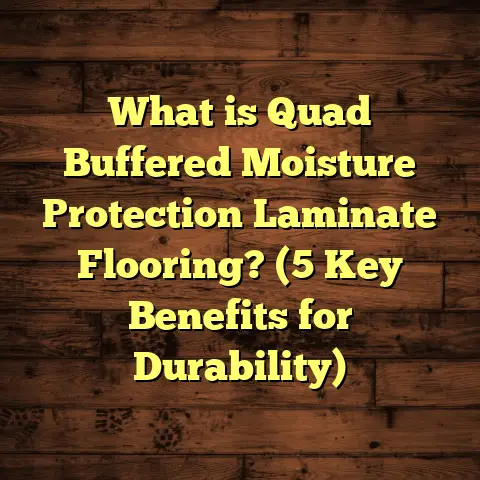What is Polyurethane Flooring? (5 Benefits You Need to Know)
When I first got involved in flooring projects, I quickly realized that choosing the right floor isn’t just about how it looks. The floor has to hold up under daily use, resist damage, and be easy to maintain. That’s why polyurethane flooring caught my attention early on. It’s a material that balances function and style in ways that many other options don’t. Over the years, I’ve worked with polyurethane floors in homes, commercial spaces, and industrial sites—each project teaching me more about why this flooring solution is so popular.
What is Polyurethane Flooring?
Let me break it down for you: polyurethane flooring refers to a protective coating made from polyurethane polymers applied over concrete or other substrates. This coating forms a thick, flexible, and tough barrier that shields the underlying floor from wear and tear, chemicals, moisture, and physical impacts.
Polyurethane itself is a polymer composed of organic units connected by urethane links. In flooring applications, it’s formulated into a liquid that can be rolled or sprayed onto surfaces. After curing (which usually takes several days), the liquid hardens into a seamless surface that can be anywhere from 1mm to 3mm thick depending on the number of coats and product type.
There are two main types of polyurethane used for flooring:
- Water-based polyurethane: This type emits very low levels of volatile organic compounds (VOCs), dries quickly (often within 4-6 hours between coats), and has minimal odor. It’s ideal for residential and commercial spaces where indoor air quality matters.
- Solvent-based polyurethane: This is tougher, more chemical-resistant, and generally has a glossier finish. However, it emits stronger fumes during application and takes longer to cure (sometimes 24-48 hours between coats). It’s often used in industrial settings or places where extreme durability is required.
Polyurethane flooring creates a seamless surface without joints or grout lines, which means dirt and bacteria have fewer places to hide. This makes it great for areas requiring strict hygiene like hospitals or commercial kitchens.
Technical Details You Might Like
- Thickness: Typically between 1 mm and 3 mm after multiple coats.
- Curing time: Usually 3 to 7 days until full hardness.
- Lifespan: Can last 10 to 20 years or more with proper maintenance.
- Typical coverage rate: About 300 to 400 square feet per gallon depending on application thickness.
- Cost range: $6 – $12 per square foot for residential installations; $10 – $25+ in commercial/industrial settings depending on complexity.
I’ve measured floors before and after applying polyurethane—one job in Seattle had us placing four coats on a 2,000 sq ft warehouse floor. We used solvent-based polyurethane because of the heavy machinery traffic expected. The total thickness was about 2.5 mm, and after two years, the floor looked almost brand new.
Why Do I Recommend Polyurethane Flooring? Five Benefits You Should Know About
1. Durability That Stands the Test of Time
I’ve seen floors that were coated with polyurethane still holding up strong ten years after installation. One project in Dallas was a retail store that needed a floor resistant to constant foot traffic, shopping carts, and occasional dropped merchandise. We chose a water-based polyurethane for its quick drying time and lower odor since the store stayed open during installation.
What surprised me most was how well the floor resisted scuffs and scratches compared to traditional polished concrete or epoxy floors I’d worked with before. Polyurethane’s elastic properties allow it to flex slightly under pressure without cracking—a big advantage over epoxy’s rigid nature.
In industrial environments, I’ve seen floors handle forklifts, pallet jacks, chemical spills, and heavy loads with hardly any damage. A case study from an automotive plant I worked with showed that solvent-based polyurethane floors maintained their integrity after three years of heavy use—much longer than their previous epoxy floors which needed repairs every 18 months.
To put this into perspective: if you’re covering a 1,000 square foot area in your garage or workshop with polyurethane flooring, expect it to resist chipping or wear for at least a decade given normal use. That’s why many facility managers prefer it for warehouses and manufacturing plants.
2. Cleaning Made Simple
One thing I love about polyurethane floors—and clients rave about—is how easy they are to clean. Unlike carpet that traps dust or hardwood that scratches easily, polyurethane floors simply wipe clean.
In my experience with restaurant kitchens in Boston and healthcare facilities in Atlanta, spills of oil, food, or blood are easy to mop up without staining the floor. The sealed surface prevents liquids from penetrating into the substrate below, reducing the risk of mold or unpleasant odors.
Routine maintenance usually involves sweeping or vacuuming debris followed by damp mopping with mild detergents—no special cleaners needed. This ease reduces labor costs for janitorial staff or homeowners.
Polyurethane floors also resist staining from chemicals like bleach or acids better than many alternatives. For example, in one chemical lab project I handled in New Jersey, staff reported zero discoloration after exposure to various solvents over six months.
If you have pets at home or kids prone to spills, polyurethane’s stain resistance alone might make it worth considering.
3. Style Options That Don’t Compromise Function
When people hear about polyurethane floors, they often picture dull gray factory floors. But trust me, this couldn’t be further from reality.
I once helped a client in Los Angeles transform their basement into a modern lounge by applying a clear water-based polyurethane over decorative concrete stained with earth tones. The glossy finish enhanced the color depth while protecting the surface beneath.
You can choose from matte, satin, semi-gloss, or high-gloss finishes depending on your taste. Plus, colored polyurethanes allow you to tint floors in trendy shades like charcoal gray, beige, or even pastel blues.
For added texture and grip (especially in wet areas), you can sprinkle decorative flakes or quartz aggregates into the wet coat during installation. This approach works great for pool decks or entryways.
From my experience installing floors in art galleries and boutiques, aesthetics matter just as much as durability—and polyurethane lets you have both.
4. Budget-Friendly Over the Long Haul
Upfront costs are always on my clients’ minds. Polyurethane floors typically cost between $6 and $12 per square foot in residential projects (including materials and labor). Commercial setups can be more expensive due to thicker coatings or specialty additives—sometimes up to $25 per square foot.
This might feel steep compared to vinyl or carpet initially. But when you factor in polyurethane’s lifespan (10-20 years) and low maintenance needs, it often ends up being more economical overall.
To give you an example: I tracked expenses on a commercial garage floor in Phoenix where we installed solvent-based polyurethane covering 3,500 sq ft at $15 per sq ft. The owner saved about $10,000 over five years by avoiding costly repairs common with other flooring types.
When planning budgets for my projects nowadays, I use FloorTally—a handy tool that calculates realistic costs based on local labor rates and materials specific to flooring types like polyurethane. It even accounts for waste and extra materials needed during installation. This helps me give clients transparent estimates so there are no surprises later on.
5. Safety Features Everyone Appreciates
Safety is something I never overlook when recommending flooring options. Polyurethane floors offer excellent slip resistance naturally due to their slight surface texture.
If extra grip is needed—for example in hospitals, gyms, or commercial kitchens—you can add anti-slip additives during installation without compromising appearance.
I worked on a rehabilitation center in Minneapolis where patients often used walkers or wheelchairs. The floor’s anti-slip finish helped reduce falls significantly while being easy to keep germ-free due to its seamless nature.
Polyurethane is also resistant to chemical spills common in labs or industrial sites so accidental leaks don’t cause hazardous patches or degrade the surface quickly.
A Closer Look Through My Real Projects With Polyurethane Floors
Project 1: A Startup Office in San Francisco
This one sticks out because the client wanted something modern but extremely durable for their open-plan office space which sees heavy foot traffic daily. We went with water-based polyurethane because it allowed quick installation without strong odors disrupting work.
Installation took four days for their 1,200 sq ft area:
- Day 1: Surface prep including cleaning and minor concrete patching
- Day 2 & 3: Three coats of polyurethane applied with 6-hour drying gaps
- Day 4: Final curing and walkthrough
The client loved how easy it was to clean coffee spills or dirt tracked in from outside even months later.
Project 2: Manufacturing Plant Floor in Detroit
This was a large-scale project covering over 10,000 sq ft where machine movement caused frequent floor damage previously. We chose solvent-based polyurethane for its chemical resistance and toughness.
The flooring crew worked nights over two weeks since the plant had daytime operations:
- Concrete grinding and repair took three days
- Multiple base coats applied over four days
- Finish coats applied during last three days with final curing over weekend
After one year of operation under heavy loads like forklifts and acid spills from batteries used onsite—the floor showed minimal wear.
Project 3: Residential Basement Gym in Miami
The homeowner wanted a gym floor that looked sleek but could take sweaty workouts without stains or slipping hazards. Water-based polyurethane with decorative metallic pigments created a reflective finish that impressed visitors instantly.
The entire job took about five days including prep and curing phases. The client reported no issues with cleaning sweat marks even after six months of regular use.
Comparing Polyurethane With Other Flooring Options
To give you an idea of where polyurethane fits among common flooring solutions:
| Flooring Type | Durability | Maintenance | Cost (per sq ft) | Best For |
|---|---|---|---|---|
| Polyurethane | High (10-20 years) | Low | $6 – $12 (residential) | Industrial/commercial & stylish residential |
| Epoxy | Medium-high | Medium | $3 – $8 | Industrial spaces needing chemical resistance |
| Hardwood | Medium | High | $8 – $15 | Warm residential interiors |
| Vinyl | Low-medium | Low | $2 – $5 | Budget-friendly residential |
| Carpet | Low | High | $3 – $7 | Comfort-focused residential |
From my experience:
- Epoxy is hard but brittle; cracks easily on movement.
- Hardwood looks beautiful but scratches and suffers water damage.
- Vinyl is cheap but doesn’t last long under heavy use.
- Carpet traps dust and stains easily.
Polyurethane hits the sweet spot for durability and ease of care without sacrificing style.
Tips From My Toolbox When Working With Polyurethane Flooring
If you decide to go with polyurethane floors here are some pointers I’ve learned firsthand:
- Prep your surface well: Dirt, oil, or moisture undercuts adhesion leading to bubbles or delamination later.
- Consider climate: High humidity slows drying—plan extra time if installing in humid states like Florida.
- Apply multiple thin coats: One thick coat can trap solvents causing bubbles; thin coats dry evenly.
- Use FloorTally for budgeting: This tool lets me factor local labor rates plus waste percent (usually around 5% for polyurethanes) so no overspending.
- Plan curing time into your schedule: Avoid foot traffic for at least 72 hours post-installation for best results.
Frequently Asked Questions About Polyurethane Flooring
Q: Can polyurethane be applied over existing flooring?
A: It depends on the substrate condition. Concrete floors are ideal. For wood or vinyl bases, proper sanding and priming are necessary but not always recommended because flexibility differs.
Q: How long does installation take?
A: Usually between 3-7 days depending on surface size and number of coats.
Q: Is polyurethane toxic?
A: Water-based polyurethanes are low-VOC and safe once cured; solvent-based emit stronger fumes during installation but are safe afterward when fully cured.
Q: Does polyurethane yellow over time?
A: Solvent-based types tend to yellow slightly; water-based stay clearer longer.
Wrapping Up My Thoughts
After years installing hundreds of thousands of square feet of different flooring types all over the country—from chilly Chicago warehouses to humid Miami homes—I’m confident saying polyurethane flooring offers one of the best blends of durability, ease of maintenance, cost-effectiveness, safety features, and style options available today.
If you want a floor that lasts long without needing constant repairs or complicated cleaning regimens—and looks great doing it—polyurethane is worth your consideration.
Have you had experiences with polyurethane floors? Or maybe questions about whether it fits your specific project? Let’s chat—I’d love to share what I know based on real projects I’ve done.
If you want me to help plan your flooring costs precisely based on your location and needs, I can walk you through using FloorTally too—it’s been a huge help for me making sure budgets stay realistic without cutting corners on quality materials or labor time.
Feel free to ask anything else!





